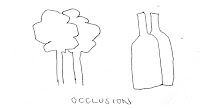If we’re thinking about the three bands of spatial depth in our environment, and how we might refer to them in drawing, it’s worth considering the ways in which we read depth in the real world, and in pictures the clues that tell us one thing is nearer than another.
The way humans make judgments about spatial depth, about what is
near and what is far, is complex and involves the interplay of a number of
sources of information. However, research literature suggests that there are
nine or ten important cues that combine to indicate depth. Some of the cues are effective only at short
range, and others only at long range.
Depth cues in the real world
1. occlusion
– if one object obscures part of
another object, then it is closer to the viewer
2. relative size
 –
if two objects of the same physical size appear different in size then the
smaller is further away. (This cue also gives information about the relative
distance - if the smaller object is half the size of the larger then it is
twice as far away)
–
if two objects of the same physical size appear different in size then the
smaller is further away. (This cue also gives information about the relative
distance - if the smaller object is half the size of the larger then it is
twice as far away) 3. relative density
 – a regular patterned surface (eg a tiled floor) will appear denser,
the further away it is Fine details on
nearby objects can be seen clearly, whereas such details are not visible on faraway
objects. On a long gravel road, the shape, size and colour of the gravel near
the observer can be clearly seen. In the distance, the road's texture cannot be
made out clearly.
– a regular patterned surface (eg a tiled floor) will appear denser,
the further away it is Fine details on
nearby objects can be seen clearly, whereas such details are not visible on faraway
objects. On a long gravel road, the shape, size and colour of the gravel near
the observer can be clearly seen. In the distance, the road's texture cannot be
made out clearly. 4. height in the visual field
 –
if two objects are on the same ground plane, then the further object will
appear to be higher in the visual field.
–
if two objects are on the same ground plane, then the further object will
appear to be higher in the visual field. 5. aerial perspective
– the further away an object is the less distinct it
appears. Owing to light scattering by the atmosphere, objects that are a great
distance away have lower contrast and colour saturation. Images seem blurry the
farther they are away from a person's point of view. This is only usually
noticeable in the distance, beyond the action space boundary.
 |
| All five of the depth cues combine together in a scene like this |
These five depth cues work in real life, and they can all be used to depict spatial depth in making pictures.
- (Next part: 4 more depth cues, that are very strong in the real world, but can't be used in drawings...)

No comments:
Post a Comment